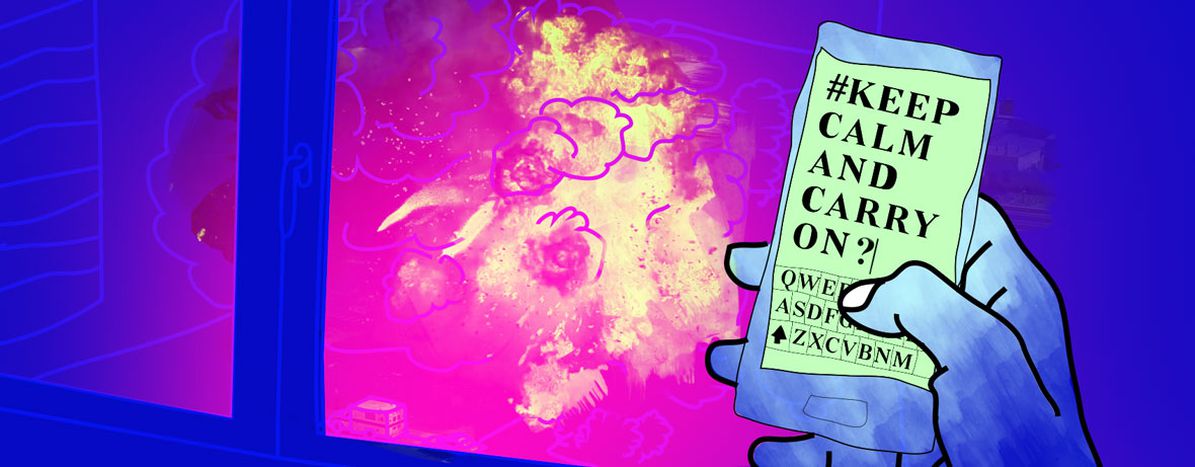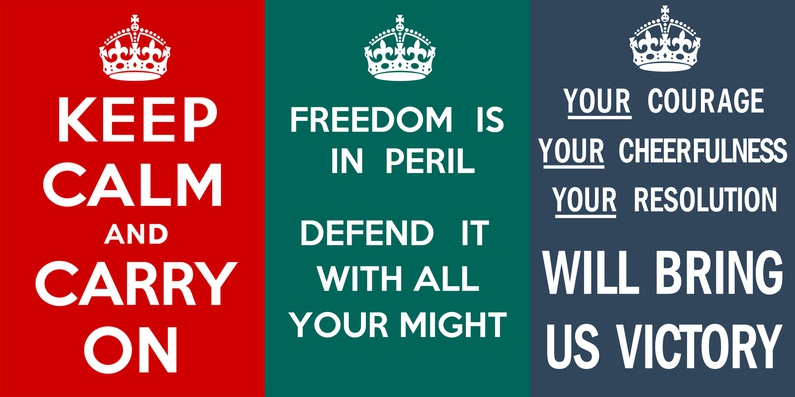
Cool Britannia, Calm Britannia?
Published on
A sharp and catchy font, a crown to match the royal poise of the words below, and a striking red back-drop: the Keep Calm and Carry On poster is dripping in Britishness. But how did these five words come to be emblematic of British culture, and do they really reflect a common mindset?
Picture this: it’s late afternoon in Alnwick, a tiny village in the north of England. An elderly couple are rummaging through a box of dusty books that they managed to retrieve from an auction. “Nabokov? Okay,” Stuart sighs, “but I can’t understand why people even buy books called An Offer From a Gentleman…” It’s always peaceful in Barter Books. With its fireplace, snug armchairs and rickety bookshelves, the shop invites all species of bookworms.
It’s on this day that Stuart discovers a large crumpled piece of paper in the box that will eventually change his life. "Keep Calm and Carry On" it reads, in big white bold letters, with a Tudor Crown to match. Intrigued by the design of the poster, Mary (his wife) decides to place it above the till. Why not? It’s time to add a little more pizzazz to the shop. A few weeks later, the couple start selling original copies to locals, initiating a regional fondness for what would later become a national trademark. True story.
It’s all just a little bit of history repeated
“Keep Calm and Carry On.” These five words have become a symbol of British culture. What they represent is the nation’s stiff upper lip, their sense of fortitude. The cliché British politeness in times of adversity, an assumption that everyone is entirely self-composed. But it is easy to forget how these five words came to be, before they landed in the hands of Stuart and Mary Manley at Barter Books.
Along with two others, the poster was originally created in preparation for World War II. In a time where the Blitz was a real threat, the government had to find ways to appease the public. Something had to be done to show that the country was prepared for a war outbreak, to stress that there was a “certainty of ultimate victory”. By early autumn 1939, about 2.45 million copies had been passed on to local distribution centres. But when push came to shove, those sanctioning the poster decided that it was too commonplace and patronising. People wouldn’t want their own government to doubt the legitimacy of their anxiety. Four weeks later, the Ministry of Information decided to abolish the whole campaign. The stocks were archived until 1940, before the UK called for a paper salvage to recycle materials to help the war effort.
Unearthing the bastion
So how does a poster with such a subversive message make it to the limelight? The butterfly effect. One small buzz in Alnwick reverberated throughout the country. After the relic turned up in Barter Books in 2000, people started helping themselves to the poster image. By 2007, Stuart claims that "copying was rife," and continues: "With or without permission... [the poster] firmly established itself as the first world-wide iconic image of the 21st century, complete with never-ending variations.” Some argue that its success was also largely due to responses to the economic crisis and credit crunch. When protests broke out, Britain needed to get back its bearings.
The popularisation of the poster came with an endless string of parodies. "Keep Calm and Carry On" soon became "Now Panic and Freak Out." At one point in the poster’s peak of fame, the British even out-Britted themselves by changing the words to "Keep Calm and God Save the Queen." But not all of these parodies were facetious. At some point, even the NHS adopted the design and took advantage of its popularity. A pink version of the poster famously read: "Keep Calm and Carry on Breastfeeding," and copies of "Keep Calm and Call 111" were hung up around cities.
New generations
Ironic, isn’t it? A poster that was initially created in case of war, then later refused due to its lack of affinity with the British people, is now a bastion of British culture.
People have been struggling to understand why the message stuck. According to Stuart and Mary Manley, there are three main reasons: the message itself is universal, the words embody a certain air of Britishness, and the fact that there is a simplicity to the design. But Stuart admits that, after having spent 17 years with the poster, he has become a bit "bleary-eyed" about it. "The poster hit its peak around about 2007 through to 2012 and since then its [popularity] is at a much lower level. I do think that it appeals to all ages, though, even if the older generation relate to it more than the young."
But when do we see the phrase re-surface today, and does it really appeal to all ages?
After the Manchester attacks last week, a general message of calm was encouraged by Theresa May, Jeremy Corbyn and Andy Burnham [NB. Mayor of Manchester]. Many Twitter users wrote about the attack using the hashtag #KeepCalmAndCarryOn, some even alluding to World War II:
Yet not all young Britons relate to the slogan, some argue that it is outdated and even dangerous. "I don't really identify with the words, although it is a typically British sentiment: the war time, the stiff upper-lip stoicism that refuses to show weakness... My parents and grandparents are very much like that. I think the intent behind that term can be pretty destructive, it doesn't encourage people to get to the root of the problem," 23-year-old George Haddon admits, a young Briton now living in Amsterdam. "People eat up all this paraphernalia, but with Brexit I'm sure it will either die off or go through the roof in a surge of nationalism, depending on the outcome of the elections."
To many young Britons, the words represent a sort of culture of complacency. It reflects an age or even a generation which refuses to tackle issues at hand, preferring to stay comfortable and unaffected. To Elliott Sadgrove (25), it is "an outdated phrase for those watching the world pass by without ever truly plugging in."
So there we have it: the history of the poster and its message is complex. Although the slogan entered the mainstream spontaneously, it's not quite sure what its future holds. Either it will live on and become re-adopted by a new generation, or it will slowly fade out. One thing is for certain: 1.1 million people between the ages of 18 and 35 have registered to vote for the general elections next week. Will they be the ones to "Keep Calm and Carry On"?



